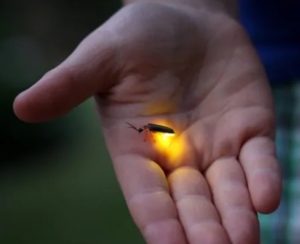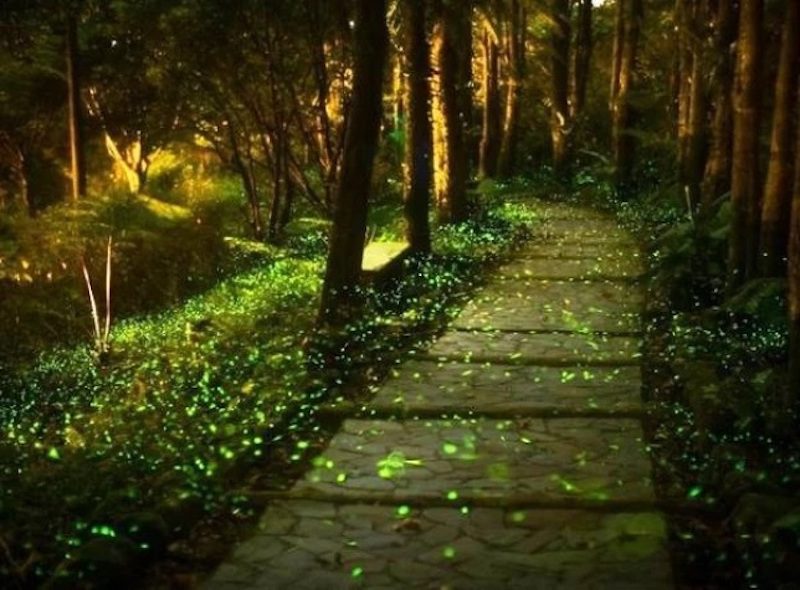It has happened so gradually that we’ve barely noticed their departure. It would be a safe bet to say that most of our children and grandchildren have never even seen a firefly.
But I remember them. We called them Lightning Bugs. Hot summer nights filled with tiny blinking lights, flitting around, staying low enough for us kids to catch in mason jars. And being disappointed the next morning to find them lying dead at the bottom of the jars. We didn’t know any better back then.

photo courtesy Jessica Lucia and the Canadian Broadcasting Company
Sadly, I can’t remember the last time I saw a firefly. Certainly not in the 20 years or so I have lived in the Lowcountry.
I was curious so I did some research on why? Well, just about everything in the modern world has contributed to the serious decline of firefly populations (like bees, butterflies and so many other pollinators). Pesticides? Of course. Loss of habitat? That, too. But the biggest culprit for fireflies is light. Yes, light. Fireflies communicate and seek mates by using their personal lights, but street lights, car lights, porch lights, neon signs and all the other artificial lights have obscured the glow produced by the fireflies themselves. So no mating, no baby fireflies.
Lowcountry gardens should be filled with fireflies. Our hot, humid climate and gardens filled with flowers, shrubs and trees are the perfect breeding ground for fireflies. Like mosquitoes, they love marshes and wetlands near water. Well, we have that in abundance, too, but we also have too much light.
We worry about Urban Blight, but we need to worry about Urban Light, too. There’s not much we can do about Urban Light, but we can make our gardens more firefly friendly. First, pesticides. Of course it’s hard to have a flourishing garden totally organically, but we can sure can reduce their use by using eco-friendly controls. And learning to live with insects and slugs. They’re food for birds, frogs, fireflies and other creatures. Slugs, especially, are a major food source for firefly larvae. Isn’t it worth having some leaves chewed on by slugs to have fireflies?

Firefly display photo courtesy East Lake Peony Garden – Hubei Province, China
Secondly, we’ve already created a habitat for them just by having a garden. Adult fireflies, like butterflies and bees, depend on nectar and pollen. And don’t mow your lawn so often. Set the mower blades high when you do. Fireflies rest on tall blades of grass during the day.
Don’t be hasty about removing all the pine trees from your property. Fireflies mate and lay their eggs in the canopy of pines, and pines provide a safe and dark place among the needles for the larvae to flourish.
Remember how the servants in Downton Abby would snap open the drapes every morning? If we cover our windows at nighttime, too, less light can escape and fireflies will be encouraged to come and stay.
Rethink your outdoor lighting. Do you really need it? Do we really need to leave a porch light on? I’ll bet you’ve forgotten how peaceful it is to sit on the back porch with just the moon and stars for lighting. I certainly had, but I’ve begun again. Try it. Either alone or with soft conversation. It will refresh your soul.
At least in some places, the loss of fireflies was noticed and efforts were being made to reverse their decline. In 2015, China opened the first firefly themed public garden.
They gathered 10,000 fireflies from interior wetlands, and released them into the East Lake Peony Garden in Hubei Province. An intensive program of breeding took place there as well. Fireflies are seasonal, and during the months from May to October, visitors flocked to the garden in the early evenings to enjoy the magic.
The park sparked having ‘firefly events’ during weddings, concerts and other outside venues all over China, so environmentalists began a campaign to stop them, citing that capturing millions of fireflies from their habitats and releasing them where they will be sure to die was counter-productive. It worked. The East Lake Peony Garden is now actually using lasers to act as artificial fireflies. I can’t think this is an improvement; now it’s just another light show.
Given the modern world, I guess it is inevitable that fireflies will be gone from urban gardens. If we’re lucky, we may be able to see a few in our own gardens from time to time by following the guidelines to attract them, but I’m not very hopeful. We’re just not successful enough at controlling the light.
If you are reading this online, please let us know – on our website or Facebook page – if you have fireflies in your garden. It would be so reassuring to know that they haven’t left the Lowcountry for good.






